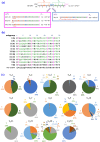The VH framework region 1 as a target of efficient mutagenesis for generating a variety of affinity-matured scFv mutants
- PMID: 33859250
- PMCID: PMC8050046
- DOI: 10.1038/s41598-021-87501-7
The VH framework region 1 as a target of efficient mutagenesis for generating a variety of affinity-matured scFv mutants
Abstract
In vitro affinity-maturation potentially generates antibody fragments with enhanced antigen-binding affinities that allow for developing more sensitive diagnostic systems and more effective therapeutic agents. Site-directed mutagenesis targeting "hot regions," i.e., amino acid substitutions therein frequently increase the affinities, is desirable for straightforward discovery of valuable mutants. We here report two "designed" site-directed mutagenesis (A and B) targeted the N-terminal 1-10 positions of the VH framework region 1 that successfully improved an anti-cortisol single-chain Fv fragment (Ka, 3.6 × 108 M-1). Mutagenesis A substituted the amino acids at the position 1-3, 5-7, 9 and 10 with a limited set of substitutions to generate only 1,536 different members, while mutagenesis B inserted 1-6 random residues between the positions 6 and 7. Screening the resulting bacterial libraries as scFv-phage clones with a clonal array profiling system provided 21 genetically unique scFv mutants showing 17-31-fold increased affinity with > 109 M-1 Ka values. Among the mutants selected from the library A and B, scFv mA#18 (with five-residue substitutions) and mB1-3#130 (with a single residue insertion) showed the greatest Ka value, 1.1 × 1010 M-1.
Conflict of interest statement
The authors declare no competing interests.
Figures





Similar articles
-
[A Novel System for Discovering High-affinity Antibody Mutants That Enables Immunoassays with Higher Sensitivities -Development and Application of Clonal Array Profiling (CAP)].Yakugaku Zasshi. 2022;142(11):1153-1159. doi: 10.1248/yakushi.22-00141. Yakugaku Zasshi. 2022. PMID: 36328444 Japanese.
-
Clonal array profiling of scFv-displaying phages for high-throughput discovery of affinity-matured antibody mutants.Sci Rep. 2020 Aug 24;10(1):14103. doi: 10.1038/s41598-020-71037-3. Sci Rep. 2020. PMID: 32839506 Free PMC article.
-
Retrieving Dissociation-Resistant Antibody Mutants: An Efficient Strategy for Developing Immunoassays with Improved Sensitivities.Biol Pharm Bull. 2022;45(10):1432-1437. doi: 10.1248/bpb.b22-00454. Biol Pharm Bull. 2022. PMID: 36184500
-
More than 370-Fold Increase in Antibody Affinity to Estradiol-17β by Exploring Substitutions in the VH-CDR3.Biol Pharm Bull. 2022;45(7):851-855. doi: 10.1248/bpb.b22-00187. Biol Pharm Bull. 2022. PMID: 35786593
-
Improvement of anti-Burkholderia mouse monoclonal antibody from various phage-displayed single-chain antibody libraries.J Immunol Methods. 2011 Sep 30;372(1-2):146-61. doi: 10.1016/j.jim.2011.07.009. Epub 2011 Jul 20. J Immunol Methods. 2011. PMID: 21787781
Cited by
-
TEMPRO: nanobody melting temperature estimation model using protein embeddings.Sci Rep. 2024 Aug 17;14(1):19074. doi: 10.1038/s41598-024-70101-6. Sci Rep. 2024. PMID: 39154093 Free PMC article.
-
Affinity maturation of TCR-like antibodies using phage display guided by structural modeling.Protein Eng Des Sel. 2022 Feb 17;35:gzac005. doi: 10.1093/protein/gzac005. Protein Eng Des Sel. 2022. PMID: 35871543 Free PMC article.
-
Preparation and application of a specific single-chain variable fragment against artemether.J Pharm Biomed Anal. 2022 Oct 25;220:115020. doi: 10.1016/j.jpba.2022.115020. Epub 2022 Aug 28. J Pharm Biomed Anal. 2022. PMID: 36049377 Free PMC article.
References
-
- An Z, editor. Therapeutic Monoclonal Antibodies, from Bench to Clinic. New York: Wiley; 2009.
-
- Dübel S, editor. Handbook of Therapeutic Antibodies. New York: Wiley-Blackwell; 2010.
-
- Wild D, editor. The Immunoassay Handbook. Amsterdam: Elsevier; 2013.
Publication types
MeSH terms
Substances
LinkOut - more resources
Full Text Sources
Other Literature Sources
Miscellaneous

